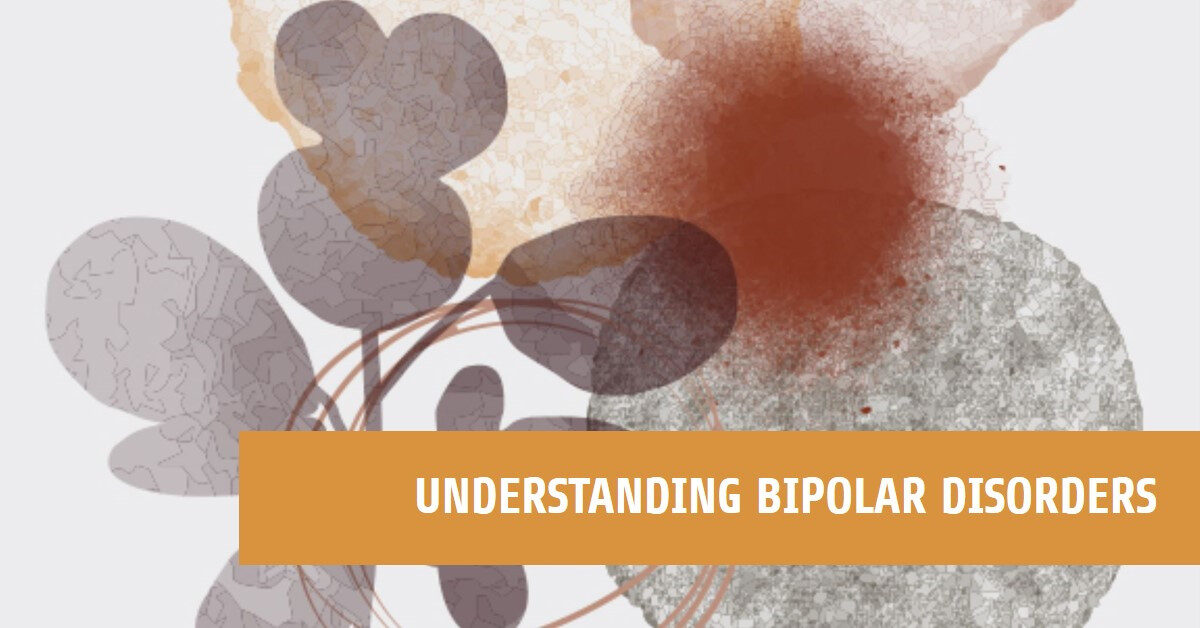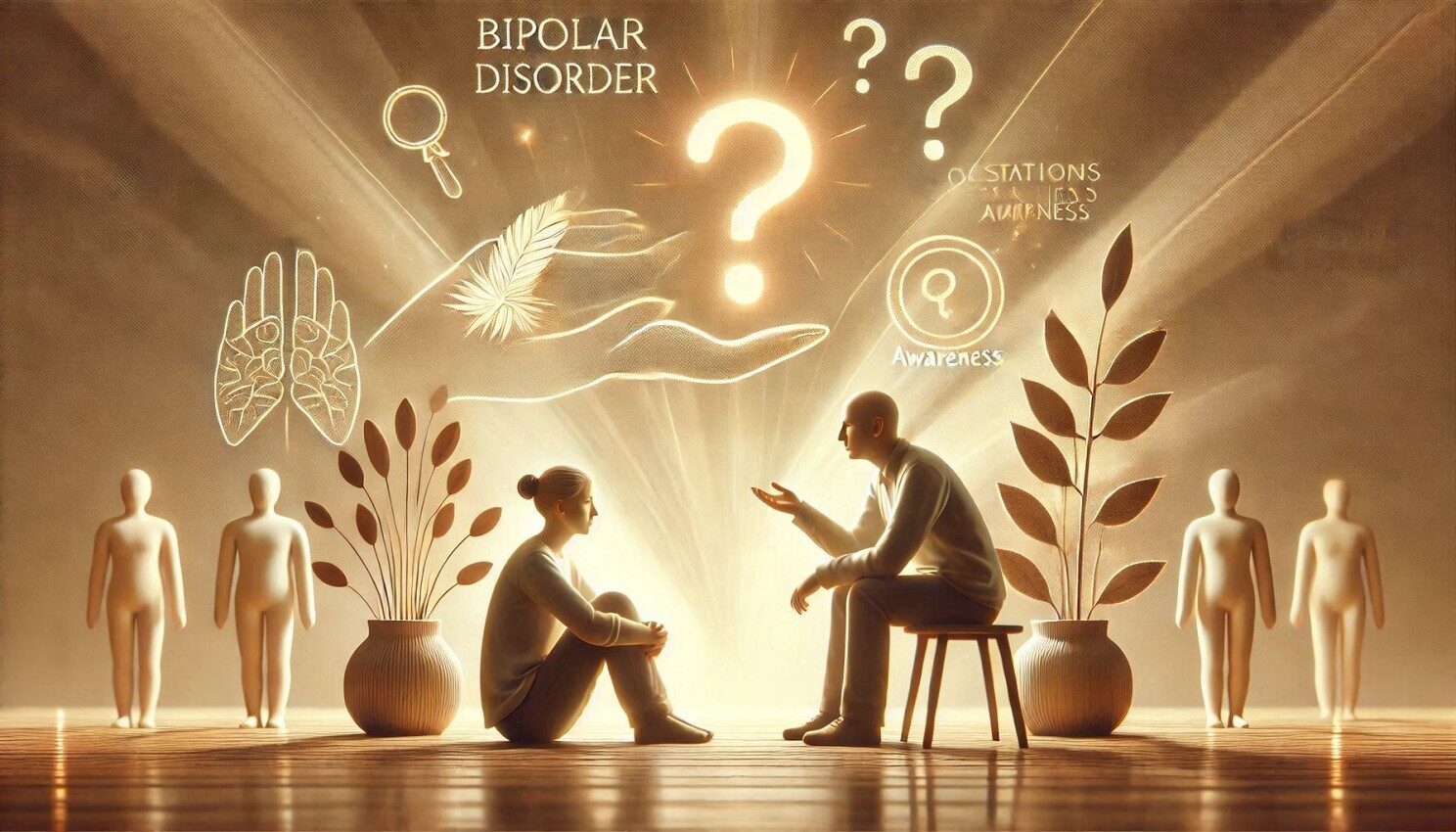

Not just the name. Not just the stereotypes. Do you know it is one of the most misunderstood mental health conditions? That it is more than just mood swings? More than highs and lows?
Right now, someone is waking up feeling like the world is at their feet, unstoppable, invincible. Somewhere else, another person struggles to get out of bed, drowning in a darkness they cannot explain. Two extremes, both consuming, both real, and both often met with silence, misunderstanding, and stigma.
It impacts nearly 1.3 million people in the United Kingdom alone, that is approximately 1 in every 50 people. Globally, the numbers soar into tens of millions. This means that realistically, whether you are aware or not, you already know someone living with bipolar disorder. They could be your friend, a colleague, a family member, or even the person you pass every day in the street.
For those living with bipolar disorder, the experience is as diverse as it is profound. It can mean days or weeks of boundless energy, racing thoughts, and an overwhelming sense of invincibility, only to be followed by weeks, or months, of immobilising despair. For some, it’s a delicate balancing act, teetering between these extremes while yearning for a sense of normality that feels forever out of reach. It is a condition that affects not just the individual but their families, friends, and workplaces, creating a ripple effect that touches every aspect of life.


Despite its prevalence, the myths and misconceptions persist. Society often paints bipolar disorder in black and white; manic happiness or crippling sadness; but the reality exists in complex shades of grey. It is not just a matter of moodiness or a failure to cope; bipolar disorder is a chronic mental health condition that requires compassion, understanding, and support.
Bipolar disorder is more than the swings of mood or energy that society, journalism, and social media often simplifies it into. It is a complex mental health condition, characterised by periods of profound highs – known as mania or hypomania– and devastating lows, often indistinguishable from major depression. For those who live with it, bipolar disorder can be both a relentless storm and a quiet, unyielding weight.
Understanding bipolar disorder is not just a “nice-to-know.” It is a “need-to-know.” Misunderstanding breeds stigma, stigma fuels silence, and silence leaves millions without the help, support, and empathy they desperately need. How many people have suffered alone, too afraid to speak up because they fear being labelled “dramatic,” “unreliable,” or “crazy”? How many lives could change if as a society, we stopped to listen, to educate ourselves, and to recognise the truth?
This post is not just about understanding bipolar disorder, it is about unearthing the experience behind the diagnosis. It is about bridging the gap between clinical definitions and lived realities, challenging the stigma that perpetuates silence, and offering hope through empathy, education, and action. Whether you are living with bipolar disorder, supporting someone who is, or seeking to learn more, this post aims to provide the depth and insight necessary to truly understand what it means to navigate the highs and lows of this condition. We will explore:
By the time you finish this post, I ask you to pause and consider:
Do you now understand what bipolar disorder truly is?
Can you recognise how deeply it impacts lives; far beyond the headlines and labels?
Bipolar disorder is not a character flaw or a failure. It is a medical condition that deserves the same level of understandi ng, compassion, and treatment as any other health issue (Mental or Physical). I hope you will not only have a clearer picture of bipolar disorder but also the tools and knowledge to make a difference.
ng, compassion, and treatment as any other health issue (Mental or Physical). I hope you will not only have a clearer picture of bipolar disorder but also the tools and knowledge to make a difference.
“The smallest spark of awareness can light the way to change.”
Every conversation about mental health brings us closer to a world where understanding replaces judgment and hope replaces despair.
Bipolar disorder is one of the most misunderstood and misrepresented mental health conditions. Often trivialised as mere mood swings or labelled as “dramatic behaviour,” the truth is more complex and deeply rooted in our brain’s chemistry. At its core, bipolar disorder is a mood disorder that affects the brain’s ability to regulate emotions, energy levels, and activity. It is not a fleeting feeling or a choice, it is a medical condition that requires awareness, understanding, and treatment.
Bipolar disorder is characterised by episodes of mania or hypomania (periods of elevated mood, energy, and activity) and depression (periods of deep sadness, lethargy, and hopelessness). These episodes can last for days, weeks, or even months, and the frequency and intensity vary significantly from person to person. The condition is typically divided into three main types:
Bipolar disorder is often reduced to stereotypes, such as someone being “moody” or “unpredictable.” These myths not only trivialise the condition but also enhance stigma, making it harder for individuals to seek help. Some common misconceptions are:






Diagnosing bipolar disorder is not straightforward. Many individuals are misdiagnosed with depression, anxiety, or personality disorders before the bipolar aspect is recognised. This is because depressive episodes are often more noticeable or distressing than manic or hypomanic episodes, which can sometimes go unnoticed. Furthermore, the stigma surrounding mental health can discourage individuals from sharing their experiences, leading to delays in diagnosis.
For those living with bipolar disorder, the internal experience often doesn’t match the external perception. The highs of mania or hypomania may be mistaken for happiness or success, while the lows of depression are dismissed as laziness or pessimism. Yet, beneath these surface judgments lies a daily battle with energy, emotions, and the fear of being misunderstood.
Understanding what bipolar disorder truly is; and what it isn’t; is the first step in breaking down the barriers of stigma and silence. It allows us to see the person behind the diagnosis and acknowledge their courage in navigating such an unpredictable and challenging condition.
Bipolar disorder is not just a clinical diagnosis; it is a lived experience; a journey through unexpected, unbelievable highs and debilitating lows that often feels like walking a tightrope without a safety net. Each day can bring uncertainty, challenge, and, for some, moments of triumph. What does it truly means to navigate life with bipolar disorder? The following includes quotes from individuals that requested to be anonymous while sharing the reality of these extremes and how they shape relationships, careers, and self-identity.
Imagine a moment when the world feels limitless. Energy surges through your body like a relentless wave, fuelling creativity, ambition, and boundless confidence. The colours of life seem brighter, and sleep becomes irrelevant because there is simply too much to accomplish. For some, it may even feel like a superpower.
The high, whether full mania or milder hypomania comes at a cost.
As one individual described:


“I felt unstoppable. I had so many ideas, so much drive. I thought I was changing the world. But when it ended, I looked around and realised I had destroyed everything I had been building for months.”
This is not a “good mood” – it is a chaotic loss of balance, and its impact ripples across every aspect of life.
Now on the opposite side of the coin, imagine that energy, that joy, and that creativity vanishing almost overnight. Suddenly, waking up feels like an impossible task. The weight of your thoughts presses you deeper into the bed, and the world seems shrouded in grey. Nothing matters, and no one could possibly understand.
The depressive episodes of bipolar disorder can be brutal and relentless:
A second individual described and shared:


“I spent weeks on the sofa, not because I was lazy, but because I could not move. My friends said I just needed to ‘snap out of it,’ but they did not understand that I physically could not. I felt like a prisoner in my own mind.”
Depression in bipolar disorder is not simple sadness, it is an all-encompassing darkness that can last for weeks, months, or even years.
For many, the journey with bipolar disorder is not just about the extremes, it is about the constant struggle to find day-by-day stability. Between the mania and the depression lies a quieter period where individuals attempt to reclaim their lives, build routines, and rebuild relationships that the disorder may have strained.
Loved ones of those with bipolar disorder often struggle to understand what the individual is going through. Partners, family, and friends may feel helpless during episodes of mania and frustrated during episodes of depression. Miscommunication is common, but so is hope.
Bipolar disorder is not just a series of highs and lows; it is a deeper human experience of struggle, resilience, and hope. Beneath the labels and symptoms are individuals fighting to live meaningful, fulfilling lives despite the chaos their brains may impose upon them.
A third individual beautifully expressed:
“I am not bipolar; I have bipolar disorder. It is not all of me, but it is part of my story. Every day, I fight to write the ending.”
Understanding the day-to-day experience is essential. It reminds us that those with bipolar disorder are not defined by their condition but by the courage they display as they navigate its complexities.
Bipolar disorder often goes unnoticed or misdiagnosed, especially in its early stages. The very nature of its contrasting episodes; manic highs and depressive lows; makes it complex to identify, leaving individuals to suffer silently. Spotting the signs early can mean the difference between a life spiralling out of control and a journey toward stability and healing. Here I attempt to unravel the critical signs of bipolar disorder and highlight why early detection and timely intervention are lifesaving.
At first glance, manic or hypomanic episodes might seem like bursts of productivity, excitement, or confidence. Beneath the surface, they carry a dangerous edge. Friends and family may mistake these periods for “just being in a good mood,” yet there are signs to watch for:
When the highs fade, the fall into depression is often devastating. Unlike the visible bursts of mania, depressive episodes may remain hidden behind closed doors, dismissed as “laziness” or “moodiness.” Recognising these signs early can save lives:
Bipolar disorder does not develop overnight. The early signs may appear in adolescence or early adulthood, but they are often dismissed as “teenage mood swings,” stress, or eccentric personality traits. Without intervention, the condition can worsen, leading to:
Remember: Conversations Save Lives
Spotting the signs of bipolar disorder requires vigilance, compassion, and courage. It means looking beyond the surface, asking difficult questions, and offering support without judgement. Early detection does not just ease the burden; it can save a life, restore relationships, and offer hope to those trapped in cycles they cannot control.

As one individual said:

“If someone had noticed the signs earlier, maybe my struggle would have been shorter. I just needed one person to say, ‘I see you, and I will help.’”
Spotting the signs is not about blame; it is about being present, listening, and acting with urgency. One conversation, one intervention, can change the trajectory of someone’s life.
Bipolar disorder is often viewed as an isolated battle; one fought silently within the mind and body of the individual. The truth is more diverse; its impact spreads far beyond the person experiencing it. Like ripples across water when a stone is dropped into the stillness of a lake, bipolar disorder touches every aspect of life: relationships and workplaces. It fractures the familiar, disrupts the stable, and tests the strength of bonds that once seemed unshakeable. Understanding this “ripple” effect is about awareness, compassion, and creating a network of support that lifts everyone affected.
The highs and lows of bipolar disorder can wreak havoc on relationships. Partners, family members, and friends may find themselves caught in the emotional crossfire, grappling with confusion, hurt, and fear.
“It felt like watching someone I love become a stranger. They made decisions I could not understand, and I felt powerless to stop it.”
Reckless spending may drain joint bank accounts, grand ideas may break stability, and irrational behaviour may damage trust. Loved ones often feel excluded from a whirlwind they cannot control.
“I wanted to reach out to them, but it was like they were behind a glass wall. I could see the pain, but I could not touch it.”
This isolation can create misunderstandings: “Why are they ignoring me?” “Why do they not care?” But depression is not a choice; it is a thief that steals connection and energy.
Workplaces are not immune to the ripple effect of bipolar disorder. The disorder challenges productivity, communication, and team dynamics, yet workplaces are often unequipped to respond compassionately.
Bipolar disorder does not just affect adults; it touches the lives of children growing up in households where a parent or sibling experiences the disorder. These children often navigate a world of confusion and unpredictability. They need understanding, reassurance, and safe spaces to express their fears.
Similarly, workplaces must realise that mental health struggles among employees are not just personal issues—they affect entire teams, businesses, and productivity. When workplaces step up, they play a critical role in breaking the ripple effect of isolation and frustration.
“Work to Live, do not Live to Work.”
This mantra, shared from generation to generation, is a reminder that work should support our lives, not consume them. Companies that recognise this balance foster healthier, happier, and more resilient employees.
While the ripple effect of bipolar disorder can be devastating, it also holds opportunity; an opportunity for relationships to deepen, and workplaces to become more compassionate.
Every friend who listens without judgement, every manager who extends a helping hand, creates a ripple of hope; a counterbalance to the struggles we all have in our lives.
Bipolar disorder, like many mental health conditions, remains wrapped in misunderstanding, judgement, and silence. These barriers feed a stigma that suffocates those living with the disorder and isolates them in their struggles.
One of the most powerful tools in dismantling stigma is conversation: open, honest, and empathetic dialogue that brings light to what has long been kept in the shadows. Conversations save lives, and Mental Health First Aiders (MHFAs) are at the forefront of this movement; breaking barriers, building trust, and providing hope.
Stigma is not just an abstract concept; it is a wall built from misconceptions, fear, and judgement. It thrives on silence.
“If I told them, would they think I was crazy? Would they still trust me at work, or would they push me away?”
Breaking the silence is not optional, it is vital.
Mental Health First Aiders (MHFAs) are not therapists, but they are frontline supporters, trained to notice signs, provide early intervention, and guide individuals toward professional help. Their role is to replace stigma with compassion, silence with dialogue, and fear with hope:
The message is clear:


“You are not alone. There is help, and I will help you find it.”
For someone living with bipolar disorder, finding help and support can feel like trying to navigate a storm. Manic highs crash into depressive lows and the middle ground seems unattainable. Treatment and support are the anchors in this storm; bridges that lead to stability, safety, and a life that feels manageable, even when the waves rage on.
Reality Check – The truth: treatment is not linear, nor is it perfect. It is raw, deeply personal, and often requires a lifetime of adjustments. What works for one person may not work for another. Some stumble in their recovery, relapse, and start again. Others fear seeking treatment altogether because of stigma or because hope feels like a cruel illusion.
Bipolar disorder cannot be “fixed” with a one-size-fits-all solution. It demands a comprehensive, multi-layered approach that addresses both the emotional chaos and the underlying biological roots.
Medication can save lives, but it is not a magic cure. For many, it acts as a foundation; a stabilising force that quiets the relentless highs and lows so they can reclaim control.
Again here is the raw reality: medication is a balancing act. Some endure years of trial and error before finding what works. The journey is riddled with side effects; fatigue, nausea, weight gain, and the crushing frustration of “Why is this not working yet?”
“The medication numbs the chaos, but it numbs me, too. How do I learn to live in the middle ground without losing myself?”
While medication stabilises the brain, therapy rebuilds the soul. It provides individuals with tools to understand their disorder, manage triggers, and navigate the emotional devastation bipolar disorder often brings.
Stability does not stop with therapy or medication; it demands a consistent, balanced lifestyle. For many, the smallest changes can mean the difference between relapse and recovery.
It is easy to dismiss lifestyle changes as “basic,” but for someone with bipolar disorder, they are anchors.


“Sticking to a routine feels like pulling myself out of quicksand. It is hard, exhausting, and relentless, but it keeps me grounded.”
Treatment does not happen in isolation. Recovery requires support; from friends, family, professionals, and workplaces.
Recovery is not a straight road; it is winding, messy, and often exhausting. There will be days when getting out of bed feels impossible and others when hope flickers like a distant light. Some bridges will collapse; others will hold. What matters is this:
No one should have to build their bridges alone.
When we talk about treatment and support, we are not just talking about medical solutions; we are talking about giving individuals a chance to breathe, to reclaim their lives, and to believe stability is possible.
Here is the most important truth:
Bipolar disorder does not define a person; it is one part of their story, not the whole.
With the right treatment, the right support, and the right compassion, people living with bipolar disorder can thrive.
Understanding bipolar disorder is not just an exercise in knowledge; it is the first, vital step toward hope. It is in the quiet spaces, when someone listens without judgement; when a question sparks awareness, or when a hand reaches out in support; that real change begins.
The reality is, bipolar disorder remains deeply misunderstood. For too long, society has painted it in extremes; either a creative brilliance glorified in popular culture or a dangerous volatility feared in silence. Neither narrative tells the whole truth, and both leave those living with bipolar disorder feeling unseen, unheard, and misunderstood.


Recovery from bipolar disorder is not linear; it is messy, exhausting, and at times seems insurmountable. Yet, within the struggle lies the remarkable human capacity for growth, change, and triumph. A persons story is not a tale of perfection; they are testaments to resilience, strength, and the power of hope.
When Michael met his wife, Clara, he did not know she lived with bipolar disorder. Their early relationship felt like a dream; adventures during Clara’s high-energy days, endless laughter, and deep connection. He also witnessed the other side: weeks where Clara withdrew, barely speaking, barely existing.
Michael describes the toughest moment:
“I felt helpless. I could not ‘fix’ her, and I resented myself for not understanding what she needed.”
Instead of walking away, Michael chose to educate himself. He attended support groups, read about bipolar disorder, and learned to listen without trying to solve. Slowly, he became Clara’s anchor; not her rescuer, but her unwavering partner.
Takeaway: Relationships can endure the challenges of bipolar disorder when built on education, understanding, and unwavering support.
For David, being diagnosed with bipolar disorder in his twenties felt like a life sentence. He was in university, juggling dreams of becoming a teacher, when a manic episode led to reckless decisions that cost him his studies and friendships. “I thought my life was over,” David recalled. The shame of his actions and the fear of being labelled “unstable” left him isolated and hopeless.
It took a compassionate psychiatrist and years of therapy to reframe David’s diagnosis; not as an end, but as a beginning.
“My disorder does not mean I am broken. It means I need to live differently, to care for myself in ways others might not,”
Today, he works as a teacher, passionately guiding young minds and creating a classroom where mental health conversations are welcome.
David’s advice to others?
“Do not let stigma rob you of your potential. You are not weak for asking for help; you are brave.”
Takeaway: Bipolar disorder may change the way life looks, but it does not diminish what is possible. Strength is found in reclaiming purpose and rediscovering hope.
These stories are not rare exceptions; they are proof of what can happen when individuals receive compassion, professional support, and understanding. Bipolar disorder can be relentless, but within its storm lies the potential for remarkable growth, healing, and reconnection.
By friends sharing these stories, I hope to dismantle the shame surrounding mental illness. We create spaces for dialogue, where no one feels alone in their journey.
“Hope is not the absence of struggle. It is believing, even in the darkest moments, that recovery is worth fighting for.”
For someone living with bipolar disorder, knowing they are not alone can make the difference between despair and hope. Imagine the impact of hearing,
“I see you. I believe in you. I am here for you.”
Those words carry weight; they are often a lifeline for someone navigating their own storm.
If you take away one thing from this post, let it be this:
Understanding is not enough on its own. True change requires action.
We must not only stand beside those living with bipolar disorder, or other mental health disorders, but we must also be there for them when their voices shake, when stigma weighs heavy, and when systems fail to provide the support they deserve.
The ongoing journey to understanding and hope begins with you: in your choices, and in how you show up for others. Your actions matter. When you choose compassion, education, and support, you create a world where no one has to feel invisible or fight alone.
Let us be the generation that transforms misunderstanding into acceptance, silence into conversation, and stigma into strength. Let us commit to being advocates; not for accolades, but because lives depend on it.
For those who are struggling today, let this post remind you: there is hope, there is help, and you are not alone. Your story matters, and your life is worth fighting for.

Microsoft Solution Architect, Senior Project Manager, and Mental Health Advocate